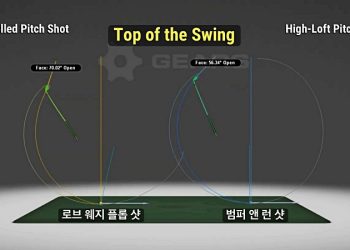짐 맥클린은 1997년 2월 ‘X팩터 스윙(The X-Factor Swing)’이라는 제목의 책을 출간했다. 이 책은 골프 스윙에서 파워와 거리를 향상시키는 방법을 다루고 있다. X팩터란 백스윙 탑에서 어깨와 엉덩이 회전의 차이를 의미한다. 하체의 강한 저항에 대해 상체를 최대한 비틀어 스윙 파워를 만드는 것이다. 그 이전까지는 엉덩이와 어깨를 최대한 회전시키라는 교습법이 주류를 이루고 있었다. 하지만 짐 맥클린은 이 책을 통해 엉덩이 회전을 최소화시키고 상체를 강하게 코일링하는 새로운 스윙 접근을 제안했다.
내가 짐 맥클린을 처음 만난 것은 2018년 초겨울이었다. 그 당시 필자는 한국의 골프 채널에서 레슨 방송을 진행하고 있었다. 필자가 기획한 ‘월드 그레이트 티처스’란 방송의 출연자로 짐 맥클린을 초대해 X팩터란 주제로 4회에 걸쳐서 촬영한 기억이 난다.
X팩터와 트랜지션의 시작은 둘 다 골프에서 거리를 내는 데 중요한 요소이지만, 필자는 트랜지션이 파워와 거리를 극대화하는 데 더 중요한 비중을 차지한다고 생각한다. 백스윙 탑에서 엉덩이와 어깨 회전의 큰 차이가 더 큰 파워 생성에 기여할 수 있지만, X팩터 단독으로는 거리를 내는 데 한계가 있기 때문이다.
이와 관련, 이번엔 로리 매킬로이의 최근 3D 촬영 자료에서 확인된 신체와 클럽 데이터를 바탕으로 X팩터와 트랜지션의 관계를 알아보자. 필자는 2011년 영국에서 로리 매킬로이를 만났었다. 당시 그의 나이는 21살, 그 이후 지금까지 톱 랭커 자리를 지키고 있다.
PGA의 톱 선수들에 비해로리의 신체 조건이 좋은 편은 아니다. 하지만 투어 평균(183cm)보다 작은 175cm의 키로 만들어내는 드라이버 샷 비거리는 PGA 투어 선수 중에서 최상이다. 2023년 시즌 PGA 투어 평균 드라이버 비거리는 326.3야드로 1위, 2024년은 317.5야드로 2위를 차지했다. 이런 비거리의 비밀은 무엇일까?
짐 맥클린의 X팩터만 가지고 설명하기에는 부족한 느낌이 있어 3D로 촬영된 자료를 바탕으로 좀 더 깊이 분석해 보았다. 먼저 골반 스웨이를 이해하기 위해 골반이 오른쪽으로 움직이면 마이너스 값(-)을, 그리고 트랜지션을 통해서 방향이 타깃으로 바뀌면 플러스 값(+)이 된다는 전제로 시작했다.
정면 모습에서 로리 매킬로이의 톱으로 이동되는 구간에 골반 스웨이 수치가 (-0.9)인 지점에서부터 분석을 시작했다. 이어 골반의 좌우 움직임이 없는(0.0) 지점을 거쳐 골반이 우측으로의 이동이 멈추는 시점의 X팩터 값은 63.75로 나왔다. 하지만 이 지점 이후에도 상체의 회전은 계속되었다. 즉 X팩터의 값은 더 크게 변화해서 스윙의 톱에서 X팩터 값이 0.41 더 커져 64.16도가 되었다. 이때 골반 스웨이는 (+0.4)로 이미 방향 전환이 이루지고 있었다. 어깨는 톱 동작으로 회전을 하고 있는 상태에서 골반 스웨이는 반대 방향으로 진행하고 있음을 알 수 있다.
눈여겨볼 부분은 톱에서 트랜지션이 시작될 때 이미 골반스웨이는 많이 진행된 상태였고 골반 회전도 함께 진행되고 있다는 점이다. 톱에서 나타난 로리의 X팩터 각도는 64.54도로 톱 동작에서 보여준 X팩터의 값 64.16보다 0.38도나 큰 각도로 어깨의 회전각도와 엉덩이의 회전각을 벌려 놓았다는 데서 그 회전을 알 수 있었다. 이 지점에서 골반 스웨이도 (+1.7)로 이동되었다. 이러한 수치 변화는 로리 매킬로이가 스윙의 탑 동작에 도달하기 전에 하체의 강한 저항을 만들면서 의도적으로 트랜지션을 하고 있었음을 말해준다.
로리맥킬로이의 트랜지션은 실제로 X팩터를 순간적으로 증가시켰다. 이것이 바로 ‘X팩터 스트레치’라는 것이다. 이런 동적인 근육 스트레칭은 더 강력한 수축을 가능하게 한다. 또한 이러한 트랜지션은 모멘텀을 만들고 다운스윙 초기에 강한 힘을 생성한다.
결론적으로 로리맥킬로이의 경우 백스윙에서 다운스윙으로의 트랜지션을 통해 클럽헤드 속도를 극대화하고, 그것이 결과적으로 거리를 내는 데 더 중요한 이유가 된 것이다.
☞ 전욱휴는…
서울대 졸업 후 미국에 유학, 1996년 PGA 클래스A 프로가 됐다. 이후 28년만인 2024년 전세계 골프계 최고 권위의 ‘PGA 마스터 프로페셔널’ 자격을 획득했다. SBS, MBC, JTBC, YTN 등의 골프 채널 진행자 및 해설자로 활약했고, 지금은 애틀랜타와 한국을 오가며 골프 레슨 및 골프 관련 비즈니스를 하고 있다. chungolf@gmail.com
[Dr Eric Chun’s 3D & Biomechanics Golf] The Secret of Rory McIlroy’s Power Swing!
The Downswing Transition Stronger than the X-Factor
Jim McLean published a book titled “The X-Factor Swing” in February 1997. This book discusses methods to improve power and distance in golf swings. The X-factor refers to the difference between shoulder and hip rotation at the top of the backswing. It’s about creating swing power by maximally coiling the upper body against the strong resistance of the lower body. Until then, the mainstream teaching method was to rotate the hips and shoulders as much as possible. However, Jim McLean proposed a new swing approach that minimizes hip rotation and strongly coils the upper body.
I first met Jim McLean in early winter of 2018. At that time, I was hosting a lesson broadcast on a Korean golf channel. I invited Jim McLean as a guest for a new program I was planning and producing called “World Great Teachers.” I remember filming four episodes on the topic of Jim McLean’s X-factor during the broadcast.
While both the X-factor and the transition are important elements in generating distance in golf, in my opinion, the transition plays a more crucial role in maximizing power and distance. Although a large difference in hip and shoulder rotation at the top of the backswing can contribute to greater power generation, research suggests that the X-factor alone may not be the most important factor in generating distance.
This time, we’ll examine the relationship between the X-factor and the transition based on recent 3D footage data of Rory McIlroy’s body and club. I met Rory McIlroy in England in 2011. At that time, Rory was 21 years old, and he has maintained his position as a top-ranked player ever since.
Compared to the top-ranked PGA players, Rory’s physical condition is not particularly advantageous. However, despite his shorter stature of 175cm compared to the tour average (183cm), his driver shot distance is top among PGA Tour players. In the 2023 season, his PGA Tour average driver distance was 326.3 yards, ranking 1st, and in 2024, it was 317.5 yards, ranking 2nd.
What’s the secret behind Rory’s driver distance? It seems insufficient to explain it solely with Jim McLean’s X-factor. We examined it through the X-factor of the swing and the transition created at the beginning of the downswing, based on 3D-captured body and club data.
To understand the pelvic sway, we started the analysis with the premise that when the pelvis moves to the right, it’s given a negative value (-), and when the pelvic sway changes direction towards the target through the transition, the pelvic sway value becomes positive (+).
From the frontal view, we began the analysis from the point where Rory McIlroy’s pelvic sway value was (-0.9) as he moved to the top. We then compared this with other measurements that appeared in 3D at the point where the value was (0.0). At the moment when the pelvis stopped moving to the right, the X-factor value was 63.75. The point where the pelvic sway is (0.0 inches) is a very brief moment with no left-right movement.
However, even after this point, the upper body rotation continued. In other words, the X-factor value changed more significantly, reaching 64.16 degrees at the top of the swing. The X-factor value increased by 0.41 degrees. At this time, the pelvic sway was already (+0.4), indicating that the direction change had already begun.
We can see that while the shoulders are rotating in the top motion, the pelvic sway is progressing in the opposite direction. What’s noteworthy is that when the transition starts at the top, the pelvic sway has already progressed significantly, and the pelvic rotation is also occurring simultaneously. We could confirm this rotation because as the downswing progressed, Rory’s X-factor angle at the top increased to 64.54 degrees, which is 0.38 degrees larger than the X-factor value of 64.16 degrees shown in the top motion, creating a wider angle between shoulder rotation and hip rotation. At this point, the pelvic sway had also moved to (+1.7).
These changes in values indicate that there are many changes in Rory McIlroy’s backswing and transition processes. This means that while creating strong lower body resistance in the process of moving to the top of the swing, the transition was intentionally made before reaching the top motion. Rotating the pelvis in the opposite direction means instantly creating a larger X-factor angle. In the downswing, the pelvic sway also moved and rotated together towards the target.
In Rory McIlroy’s swing, the transition from backswing to downswing became more important in generating distance. Through this transition, the clubhead speed was maximized.
Rory McIlroy’s transition actually increased the X-factor momentarily. We call this the “X-factor stretch.” This dynamic muscle stretching allows for more powerful contraction. Also, this transition creates momentum and generates strong force at the beginning of the downswing. This initial force generation is crucial in achieving high clubhead speed at impact. The transition occurs very quickly (about 100-150 milliseconds). It becomes an important moment for various body parts to work together efficiently.
This was an opportunity to explain in detail, through 3D numbers, Rory McIlroy’s biomechanics, where the transition creates the entire downswing and efficiently transfers energy from the body to the club.
Dr. Eric Chun
PGA Master Professional





![[전욱휴의 골프 레슨] 41. 매킬로이 파워 스윙](https://www.atlantajoongang.com/wp-content/uploads/2025/01/qQ1KakaoTalk_20250122_123635940-750x422.jpg)













![[전욱휴의 골프 레슨] 46. 배치기(얼리 익스텐션)](https://www.atlantajoongang.com/wp-content/uploads/2025/03/photoKakaoTalk_20250306_073237889_01-350x250.jpg?v=1741361116)
![[전욱휴의 골프 레슨] 45. 임성재 '행온페이드' 샷](https://www.atlantajoongang.com/wp-content/uploads/2025/02/collage1-350x250.jpg)
![[전욱휴의 골프레슨] 44. 일관된 샷을 원한다면](https://www.atlantajoongang.com/wp-content/uploads/2025/02/QKakaoTalk_20250212_065748485-350x250.jpg)

![[전욱휴 골프 레슨] 42. 오른쪽 팔꿈치 역할](https://www.atlantajoongang.com/wp-content/uploads/2025/01/qQ1KakaoTalk_20250130_072058648-350x250.jpg)
![[전욱휴의 골프레슨] 40. 3대1 스윙 템포 만들기](https://www.atlantajoongang.com/wp-content/uploads/2025/01/Q1KakaoTalk_20250114_083253266-350x250.jpg)







